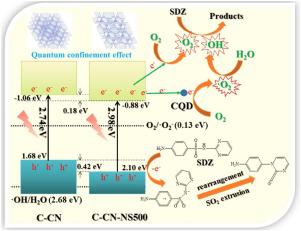Journal of Environmental Chemical Engineering ( IF 7.4 ) Pub Date : 2020-10-18 , DOI: 10.1016/j.jece.2020.104612 Yi Duan , Shukui Zhou , Lin Deng , Zhou Shi , Haiyan Jiang , Shuai Zhou

|
A metal-free environmentally-friendly and highly efficient photocatalyst is always desirable for photocatalytic remediation of antibiotic contamination. Herein, we firstly reported a novel g-C3N4/carbon dots nanosheets (C-CN-NS) nanocomposite photocatalyst which was prepared through a simple thermal oxidation etching process to remove a representative antibiotic sulfadiazine (SDZ). The degradation rate of SDZ by C-CN-NS500 (calcination temperature at 500 ℃) was around 2.4 times larger than that of g-C3N4/carbon dots (C-CN) under visible light (λ > 420 nm) irradiation. The valence band of C-CN-NS500 increased by 0.42 eV under the quantum confinement effect, which promoted the oxidation potential, in favor of the degradation of SDZ. Increased specific surface area, improved separation efficiency and prolonged contact time for C-CN-NS500 can also facilitate the degradation of SDZ. Experiments demonstrated that photo-induced hole (h+) has the strongest effect in photocatalytic degradation process, followed by  O2−, and
O2−, and  OH. The toxicity assessment showed that C-CN-NS500 nanocomposite has high biocompatibility and low toxicity. This work may provide a promising green photocatalyst for photocatalytic degradation of antibiotic contaminant.
OH. The toxicity assessment showed that C-CN-NS500 nanocomposite has high biocompatibility and low toxicity. This work may provide a promising green photocatalyst for photocatalytic degradation of antibiotic contaminant.
中文翻译:

纳米约束下通过gC 3 N 4 /碳点纳米片增强的磺胺嘧啶光催化降解:合成,生物相容性和机理
对于抗生素污染的光催化修复,总是需要无金属的环保高效的光催化剂。本文中,我们首先报道了一种新型的gC 3 N 4 /碳点纳米片(C-CN-NS)纳米复合光催化剂,该光催化剂是通过简单的热氧化蚀刻工艺制备的,以去除代表性的抗生素磺胺嘧啶(SDZ)。C-CN-NS500(煅烧温度为500℃)对SDZ的降解速率是gC 3 N 4的2.4倍左右/碳点(C-CN)在可见光(λ> 420 nm)照射下。在量子约束作用下,C-CN-NS500的价带增加了0.42 eV,从而促进了氧化势,有利于SDZ的降解。C-CN-NS500的比表面积增加,分离效率提高和接触时间延长,也可以促进SDZ的降解。证明光致孔(H实验+)具有在光催化降解过程作用最强,其次是 ö 2 - ,和
ö 2 - ,和 OH。毒性评估表明,C-CN-NS500纳米复合材料具有较高的生物相容性和较低的毒性。这项工作可能为抗生素污染物的光催化降解提供有前途的绿色光催化剂。
OH。毒性评估表明,C-CN-NS500纳米复合材料具有较高的生物相容性和较低的毒性。这项工作可能为抗生素污染物的光催化降解提供有前途的绿色光催化剂。











































 京公网安备 11010802027423号
京公网安备 11010802027423号